Georgia's Unspoiled Barrier Islands Are All About Cultural and Natural Preservation — Here's What It's Like to Visit
- Oops!Something went wrong.Please try again later.
For generations, the unspoiled islands along the coast of Georgia have been a treasured getaway. Today, they are setting the bar for cultural and natural preservation.
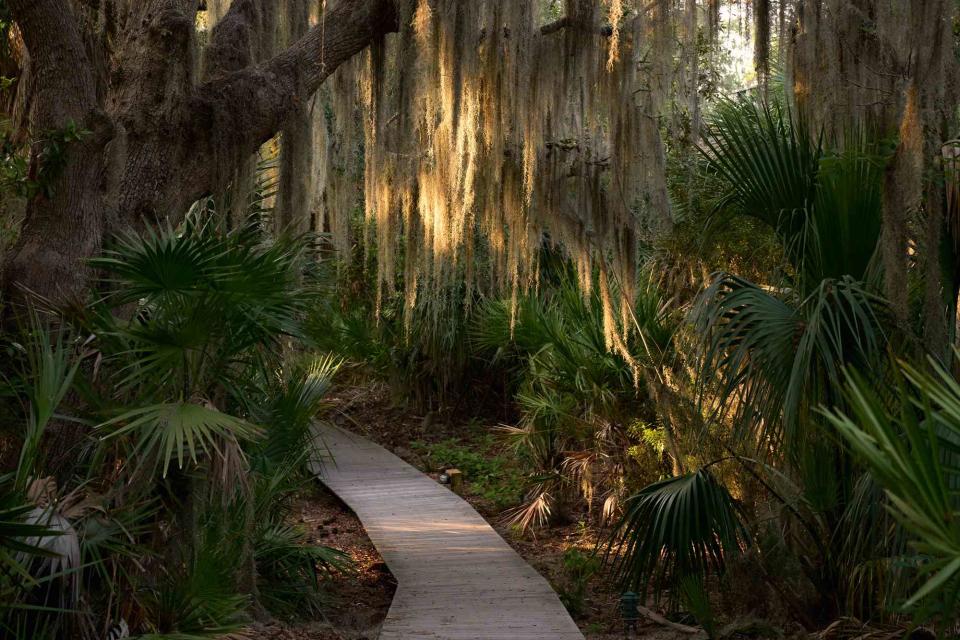
Lindsey Harris Shorter
Palms and Spanish moss-covered trees grow over a pathway on Little St. Simons Island, in Georgia.The Georgia coastline is not a clear boundary between land and sea. Rather, it’s an irregular, fluid line defined by barrier islands: puzzle pieces covered by saltwater marshes and old oak forests and crisscrossed by creeks and estuaries. These landforms act as a buffer, protecting the mainland from the storms that blow in off the Atlantic Ocean.
Over the centuries, these 15 barrier islands have been populated by many: Indigenous peoples, including the Creeks and the Guale, Spanish missionaries, pirates, plantation owners, enslaved workers, and, later, wealthy industrialists like the Carnegies and the Vanderbilts. Yet the islands have never been conquered by mass tourism. That’s partly because some of them remained, until recently, retreats for the heirs of those privileged families. Slowly, some have been acquired by the state, but many have still not been developed with hotels and resorts. Only four can be accessed by road; the rest are reachable only by boat.
Being relatively untouched, the islands have been left as habitat for vulnerable species, such as loggerhead sea turtles, manatees, and right whales. Recently, there has been a growing awareness that the islands’ diverse cultures and layers of history also require protection and attention. Even the most traditional properties in the region have begun offering tours and experiences that allow guests to develop a more complex understanding of history.
Over the course of several weeks, I visited four of Georgia’s barrier islands, each with a distinct identity: Cumberland, Sapelo, Sea Island, and Little St. Simons. Exploring these places, I found, is as much about excavating our country’s forgotten past as it is about discovering a singular landscape of ancient oak trees and estuaries. Along the way, it became clear to me that when we protect ecosystems, we must also preserve the histories and artifacts of the people who have lived within them over time.
Related: Travel + Leisure Readers' 15 Favorite Islands in the Continental U.S. of 2023
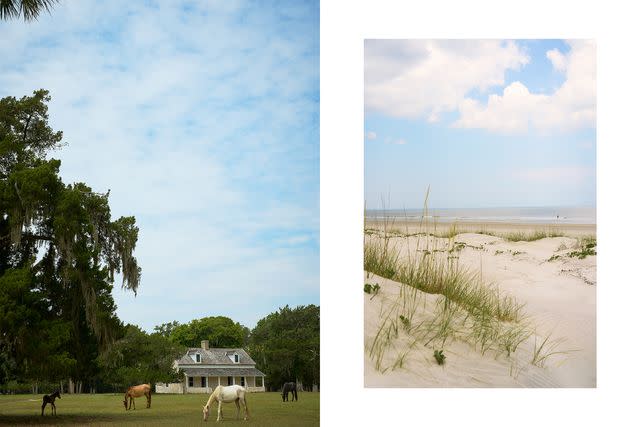
Lindsey Harris Shorter
From left: Wild horses grazing on Cumberland Island; a stretch of Cumberland's sand dunes.Cumberland Island
One humid morning, my family and I, along with four other passengers, boarded the Lucy R. Ferguson, an elegantly tricked-out lobster boat. We were headed to Greyfield Inn, on Cumberland Island, Georgia’s largest and southernmost barrier island, which is protected as a National Seashore. Apart from several small campgrounds, Greyfield is the only place to stay. For guests, the inn offers private ferry service from Fernandina Beach on Amelia Island, right on the Florida-Georgia state line. (Day visitors and campers can board a commercial ferry from St. Marys, Georgia.)
Our captain was Greyfield’s owner, Mitty Ferguson: the grandson of the boat’s eponymous Lucy and the great-great-grandson of the industrialist Thomas Carnegie. In 1900, Carnegie built Greyfield for his daughter Margaret; the home was converted into an inn by Lucy, Margaret’s daughter, in 1962.
During the 45-minute cruise, Ferguson regaled us with stories of the inn’s past. John F. Kennedy Jr. and Carolyn Bessette’s wedding guests stayed at Greyfield in 1996; Ferguson’s sister, a jewelry designer and friend of Kennedy’s, made the couple’s gold wedding bands, using the vertebrae and rib of a local rattlesnake as a mold.
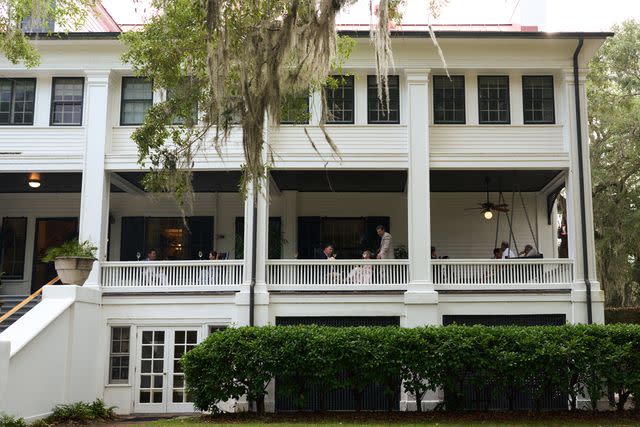
Lindsey Harris Shorter
Evening drinks on the Greyfield Inn’s porch.Before long, we arrived at Greyfield. The 15 rooms in the Colonial Revival–style manor are decorated with antiques and four-poster beds. (We stayed in one of the property’s two cottages: ours had three bedrooms, a claw-foot tub, and a porch with a wooden swing.) Greyfield evokes a different time: evening meals are sit-down affairs, with jackets required for men. There is no Wi-Fi, and wild horses graze on the lawn.
Our days were simple: we leafed through old books or played chess in the sitting room, which is decorated with family portraits and the many shells and bones Lucy collected during her years on the island. We rode bikes to the sea, traveling along a dirt track over which oak trees, dripping with Spanish moss, arched to create a natural tunnel. The only creature we met on the pristine beach was a fawn gazing at us from the dunes.
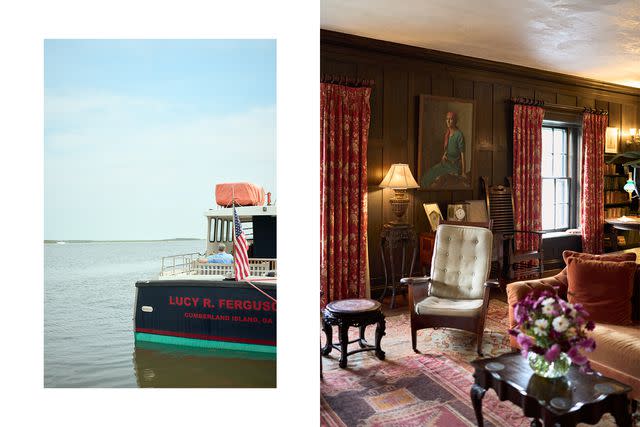
Lindsey Harris Shorter
From left: The ferry to Cumberland Island; the lounge at Greyfield Inn.One afternoon, I hopped onto the back of a truck driven by Christina Nelson, one of the inn’s naturalists, who was leading guests on a tour. We bumped along through forests of pine and oak, passing several estuaries dotted with bright white ibises and herons. We were headed to the Settlement, the official name for an area settled by former slaves in the 1890s. A half dozen buildings in various states of disrepair remain, including the tiny First African Baptist Church, which was established in 1893. (The church is where JFK Jr. and Carolyn Bessette held their wedding ceremony.)
Nelson informed us that, before the Civil War, much of Cumberland had been owned by Robert Stafford, who oversaw 8,000 acres, which were labored on by hundreds of enslaved people. (It was Stafford’s heirs who, in the 1880s, sold much of the island to Carnegie.) Soon after arriving at the Settlement, we took turns entering the tiny church, the only structure that appeared to have been recently maintained. One of the guests asked, “Who decides which buildings to preserve and which not to?” It was an excellent question — one that seemed, to me, to define the modern dilemma of these islands. (Doubles at Greyfield Inn from $745.)
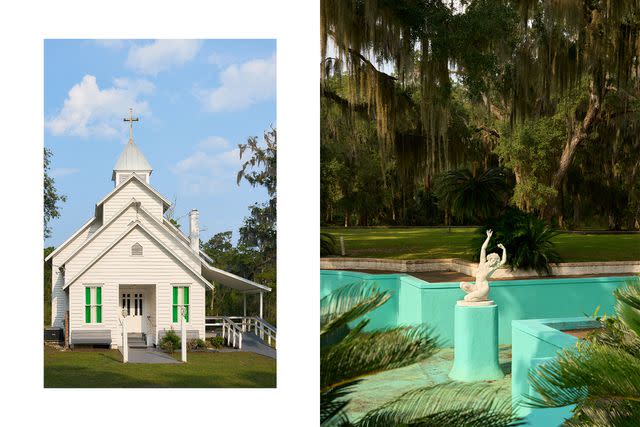
Lindsey Harris Shorter
From left: St. Luke Baptist Church in Hog Hammock, a Gullah-Geechee community on Sapelo Island; a statue in the fountain at Reynold's Mansion, on Sapelo.Sapelo Island
I found more of that tension about preservation, as well as more remarkable beauty, on the island of Sapelo, a wild piece of land with more than five miles of undeveloped, dune-lined beaches. The island is 2,000 acres larger than Manhattan, but has fewer than 50 full-time residents, almost all of whom are part of the Gullah-Geechee community and descendants of formerly enslaved West and Central African people.
“Someone should be restoring these slave quarters,” noted Annita Thomas, the host of a radio show about travel, who guided me around the island. We stood near a field of long grass that contained the ruins of the Chocolate Plantation, a cotton estate built in 1818 by slaveholder Edward Swarbreck. Thomas pointed to a small ruin constructed of tabby (a type of concrete made from lime, shells, sand, and ash) that was being swallowed up by vines. “Preserving those spaces is just as important as preserving the plantation houses. If you could step inside those cramped rooms, you’d have a greater understanding of the lives of those who had to make them their home,” she said.
Sapelo is unique because it’s the only barrier island in Georgia where the Gullah-Geechee community has lived continuously. When the plantation system began to break apart toward the end of the Civil War, General William Sherman’s Special Field Order No. 15 (the source of the phrase “40 acres and a mule”) called for land, including Georgia’s barrier islands, to be set aside for formerly enslaved people. Families were entitled to 40 acres each.
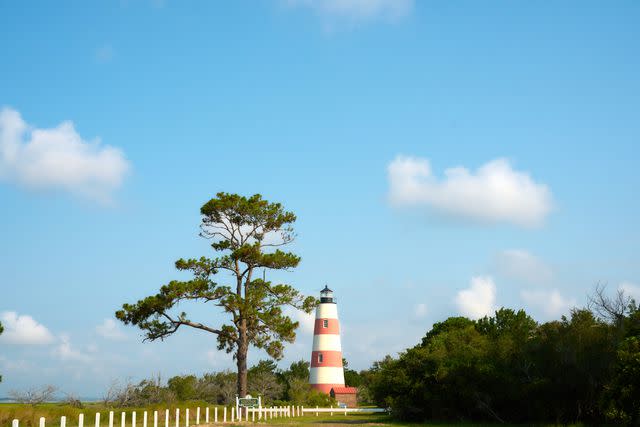
Lindsey Harris Shorter
The Sapelo Island lighthouse, built in 1820.Although President Andrew Johnson revoked the order less than a year later, some of the freedmen on Sapelo managed to hold on to (and pay taxes for) their promised acres. There are families living there that can trace their roots on the island back 10 generations. “Having a record of your ancestry as far back as that is so rare for most African Americans,” said Thomas, who discovered Sapelo on her honeymoon with her husband, Bill.
On that first trip they met and befriended author Cornelia Walker Bailey, then the island’s unofficial mayor, who eventually helped the couple buy some land. In 2011, the Thomases built Sapelo Island Birdhouses, two self-catering guesthouses on stilts with views of the marshes and the ocean beyond. Each cottage also comes with a golf cart — the only way to get around the island. They recently turned a former candy store into two guest suites.
The other place to stay, besides a campground, is the Reynolds Mansion — named for Richard Reynolds Jr., an heir to a tobacco fortune. The property is managed by the state of Georgia and can only be reserved for large groups. The elegant two-story manor has 10 bedrooms, an empty fountain pool with a marble statue of a nymph in its center, and murals by the Italian-born artist Athos Menaboni, who settled in Georgia in the 1920s.
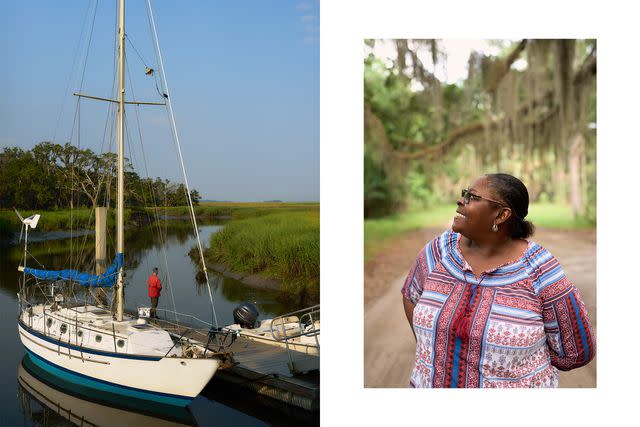
Lindsey Harris Shorter
From left: A sailboat at the dock on Sapelo Island; Sharron Grovner, a Sapelo Island tour guide.Like most of the properties that still stand on the barrier islands, its existence is complicated: it has a history of oppression — from 1810 until the end of the Civil War, the estate operated as a cotton and sugar plantation — yet it currently provides much-needed jobs. The Birdhouses, too, were conceived to help the local economy. As Bill Thomas told me, they wanted “to spark revenue and employment, to help keep young people on the island and living on their ancestral lands, raising their kids here and preserving their cultural traditions.” (Doubles at Sapelo Island Birdhouses from $255.)
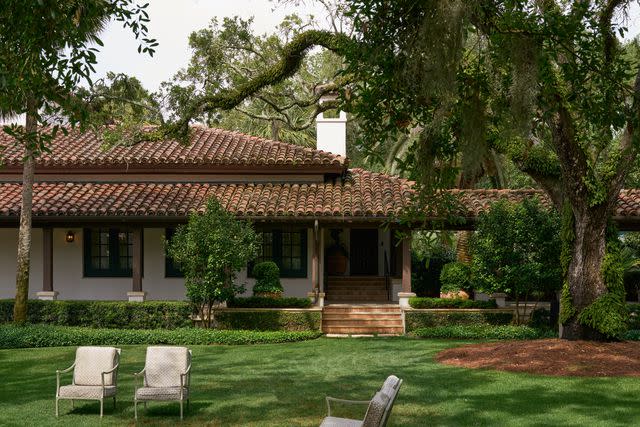
Lindsey Harris Shorter
The Cloister at Sea Island, one of the country's most storied retreats, has hosted more than six U.S. presidents.Sea Island
I soon learned that the history of Sapelo is intertwined with Sea Island, one of the country’s most exclusive enclaves. In 1934, Reynolds purchased much of the island from automobile magnate Howard Coffin, who was selling it so he could invest in Sea Island, which he’d purchased eight years earlier. Coffin’s improvements included the Cloister at Sea Island Resort, which today remains one of the country’s most elegant getaways. It’s also on one of the few barrier islands you can drive to.
The Cloister, with its elegant Spanish-colonial-style stucco main building, reminded me of a Palm Beach estate, and in a sense it is — the original 1928 mansion was designed by Addison Mizner, who defined South Florida’s Roaring Twenties architecture. It feels like a sprawling, but relaxed, country club, and families look forward to returning year after year.
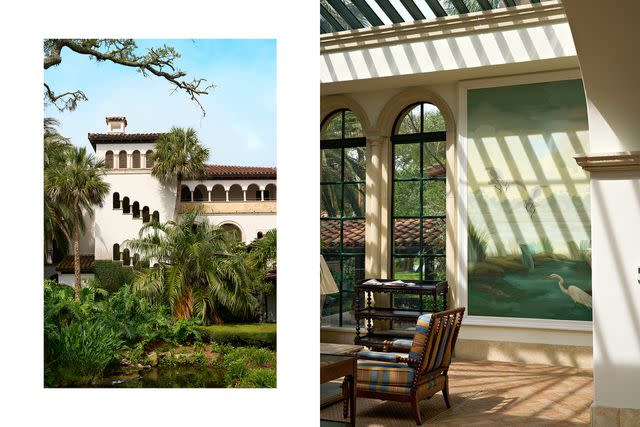
Lindsey Harris Shorter
From left: Spanish-style architecture at the resort; the solarium at the Cloister at Sea Island Resort.Related: 15 Best Places to Visit in Georgia — From Charming Mountain Towns to Sandy Beaches
The property comprises a 265-room main house, five miles of private beach, a massive spa hidden amid palms and fountains, three golf courses, six restaurants, and a beach club with three pools. (In addition to the Cloister, Sea Island Resort also operates the 43-room Lodge and the 85-room Inn, both of which are on neighboring St. Simons Island. Multi-bedroom cottages are also available.) Since its opening, Sea Island has played host to titans of industry and heads of state, including Presidents Coolidge, Eisenhower, Ford, Carter, and both George H. W. and George W. Bush. In 2004, it was the site of the G8 Summit.
Of all the barrier islands, Sea Island might be the one that most clearly reflects the region’s history of wealthy ownership. In 2016, Colorado billionaire Philip Anschutz — who also owns the Broadmoor in Colorado Springs — purchased the entire island and put it in a 100-year trust.
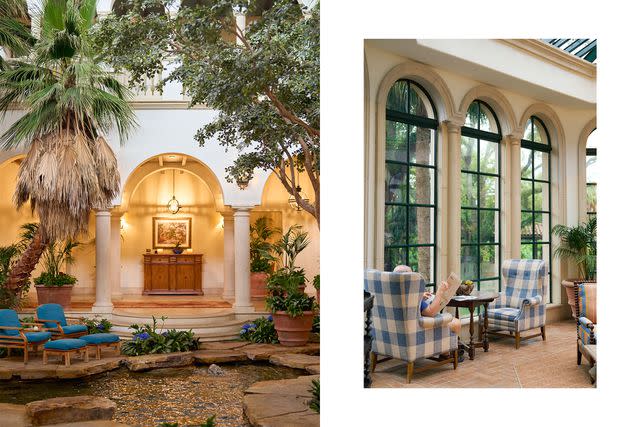
Lindsey Harris Shorter
From left: The entrance to the spa at the Cloister at Sea Island; a quiet moment in the solarium.In addition to outdoor adventures like kayaking, fishing, bird-watching, and horseback riding, the Cloister runs a fantastic nature center that is driven by the preservation efforts of Anschutz’s trust. One morning, my children and I went on a patrol for loggerhead turtles with a naturalist. We learned that global warming is causing more female turtles to be born than males. The sex of a baby is determined by the temperature of the nest, and if the eggs incubate above 88.8 degrees, the hatchlings will be female. It was a small reminder that, even in a space as well-protected as this one, change can creep in. (Doubles at the Cloister at Sea Island Resort from $609.)
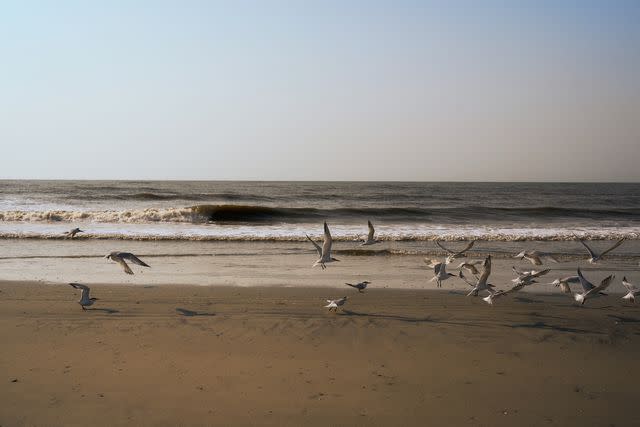
Lindsey Harris Shorter
Seagulls fly over the island’s beach on Little St. Simons Island.Little St. Simons Island
My last stop was Little St. Simons, an 11,000-acre island that is part of the Altamaha River Delta, a mixed environment of marshes, mudflats, sandspits, and small islands covered with old-growth cypress and oak forest. The land has been largely untouched for centuries — the Mocama and the Guale tribes had a presence on neighboring St. Simons Island, and while there is little information about Indigenous groups on Little St. Simons, shell middens suggest there was travel between the two.
The island has been in private hands since 1760, when the British crown granted it to Samuel Ougspourger, a Swiss colonist living in Savannah. In the early 1900s, it became a hunting estate for the Berolzheimer family; in 1979, they opened up the island, and the namesake lodge, to the public.
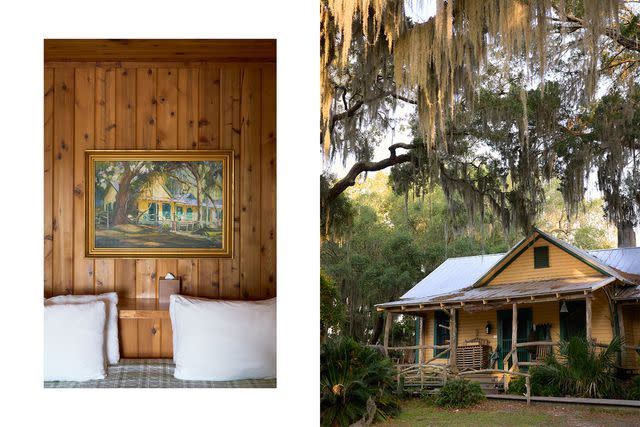
Lindsey Harris Shorter
From left: A guest room at the Lodge at Little St. Simons Island; the Hunting Lodge at Little St. Simons was built in 1917.Starting in 2003, Henry Paulson Jr. (who served as U.S. Treasury Secretary under President George W. Bush) and his wife, Wendy, gradually began buying parcels of the land, including the lodge, and in 2015, they placed the entire island in a permanent conservation easement with the Nature Conservancy, a global environmental nonprofit. This means the island cannot be further developed, and the plant and animal species that live there are protected in perpetuity.
The journey to this pristine escape begins with a 45-minute private boat ride from St. Simons Island (which is now highly built up) to the resort’s dock. With only 16 rooms in the original lodge, plus six cottages, the atmosphere is intimate and relaxed. A stay includes two daily adventures with the knowledgeable naturalists and all meals. (My favorite was local trout with chimichurri sauce.)
One day, we went fishing and then walked the shoreline with a graduate student who was researching the young sharks that inhabit the tidal waters. On the way back to the lodge, our truck had to stop for a hulking alligator, coated in bright-green algae, that had decided to take a break in the middle of the dirt track. Of all the adventures we had in Georgia, this is the moment that my children still talk about with excitement.
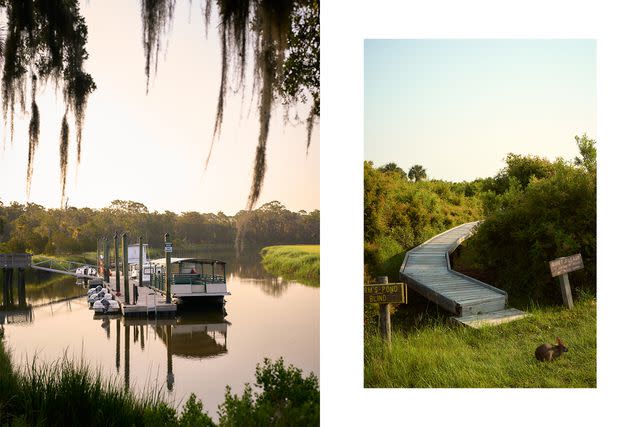
Lindsey Harris Shorter
From left: The dock on Little St. Simons Island; a rabbit near a walkway to a wildlife-watching blind on Little St. Simons.Another day we went kayaking on the edges of the island, spotting the fire-red bills of the American oystercatcher, a common sighting on Gulf Coast beaches. Little St. Simons is an important stopover for migrating birds — some 250 species are regularly spotted there.
That evening, a guide took us back to the beach to watch the hatching of baby sea turtles, which emerge during the nightto avoid detection by predators. We huddled together on the sand to wait. Soon, it began. Watching them crawl across the sand, one by one, deliberately inching toward the sea, I was filled with a sense of wonder at how little this landscape had changed through the centuries. (Doubles at the Lodge at Little St. Simons from $675, all-inclusive.)
For more Travel & Leisure news, make sure to sign up for our newsletter!
Read the original article on Travel & Leisure.

